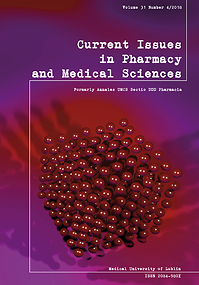Evaluation of the impact of the proteasome inhibitor on calcium channel expression in cardiomyocytes treated with doxorubicin
DOI:
https://doi.org/10.1515/cipms-2018-0004Keywords:
doxorubicin, bortezomib, proteasome, cardiotoxicity, calcium channelsAbstract
One of the less known mechanisms of doxorubicin action is the effect on the functioning of the ubiquitin-proteasome degradation system (UPS). So far, the role of impaired proteasome activity in the development of anthracycline cardiomyopathy has not been clarified. It has been shown, however, that doxorubicin decreases the expression of proteins, including the expression of the calcium channel. However, it has not been established whether the observed disturbances are due to the activation of the UPS system by doxorubicin, or due to inhibition of translation or transcription. Therefore, the aim of the study was to evaluate the mRNA and protein expression of plasmalemmal (NaCaX, L-type) and sarcoplasmic reticulum (SERCA2, RyR2) channels in rat embryonic cardiomyocytes treated with doxorubicin and the proteasome inhibitor – bortezomib. The study was conducted utilizing the rat cardiomyocyte H9C2 line that was treated with doxorubicin and bortezomib in different concentrations. After 24 hours incubation, mRNA and protein expression analysis followed. The study did not show any universal mechanism of doxorubicin influence on calcium channel expression. With regard to the Na/Ca exchanger, we saw that DOX decreased the protein level in a proteasome activitydependent manner. Moreover, we noted that the SERCA2 protein expression level was regulated by degradation intensity, however at the same time, no significant effect of doxorubicin on the level of this protein was demonstrated.
References
1. Minotti G, Menna P, Salvatorelli E, Cairo G, Gianni L. Anthracyclines: molecular advances and pharmacologic developments in antitumor activity and cardiotoxicity. Pharmacol Rev. 2004;56:185-229. 10.1124/pr.56.2.6
2. Praet M, Pollakis G, Goormaghtigh E, Ruysschaert JM. Damages of the mitochondrial membrane in Adriamycin treated mice. Cancer Lett. 1984;25:89-96. 10.1016/S0304-3835(84)80030-0
3. Zhou S, Starkov A, Froberg MK, Leino RL, Wallace KB. Cumulative and irreversible cardiac mitochondrial dysfunction induced by doxorubicin. Cancer Res. 2001;61:771-7.
4. Arai M, Tomaru K, Takizawa T, Sekguchi K, Yokoyama T, Suzuki T, et al. Sarcoplasmic reticulum genes are selectively down-regulated in cardiomiopathy produced by doxorubicin in rabbits. J Moll Cell Cardiol. 1998;30:243-54. 10.1006/jmcc.1997.05889515001
5. Gambliel HA, Burke BE, Cusack BJ, Walsh GM, Zhang YL, Mushlin PS, et al. Doxorubicin and C-13 deoxydoxorubicin effects on ryanodine receptor gene expression. Biochem. Biophys. Res. Commun. 2002;291:433-8.
6. Jensen RA. Doxorubicin cardiotoxicity: contractile changes after long-term treatment in the rat. J. Pharmacol. Exp. Ther. 1986;236:197-203.
7. Ryan T, Sharma P, Ignatchenko A, MacLennan DH, Kislinger T, Gramolini AO. Identification of novel ryanodine receptor 1 (RyR1) protein interaction with calcium homeostasis endoplasmic reticulum protein (CHERP). J. Biol. Chem. 2011;286(19):17060–8.
8. Dudka J. Rola reaktywnych form tlenu i azotu w zaburzeniach komórkowej homeostazy wapnia i żelaza w kardiotoksyczności antracyklinowej. Postepy Hig Med Dosw. 2006;60:241-7.
9. Vangheluwe P, Wuytack F. Improving cardiac Ca2+ transport into the sarcoplasmic reticulum in heart failure: lessons from the ubiquitous SERCA2b Ca2+ pump. Biochem Soc Trans. 2011;39:781–7. 10.1042/BST039078121599649
10. Arbabian A, Brouland JP, Gélébart P, Kovàcs T, Bobe R, Enouf J, et al. Endoplasmic reticulum calcium pumps and cancer. Biofactors. 2011;37(3): 139-49. 10.1002/biof.14221674635
11. Olson RD, Gambiel HA, Vestal RE, Shadle SE, Charlier HAJr, Cusack BJ. Doxorubicin cardiac dysfunction: Effects on calcium regulatory proteins, sarcoplasmic reticulum, and triiodothyronine. Cardiovasc. Tox. 2005;05:269-83.
12. Korga A, Dudka J, Burdan F, Sliwinska J, Mandziuk S, Dawidek-Pietryka K. The redox imbalance and the reduction of contractile protein content in rat hearts administered with L-thyroxine and Doxorubicin. Oxid Med Cell Longev. 2012;681367. 10.1155/2012/681367331706122530076
13. Szuławska A, Czyż M. Molekularne mechanizmy działania antracyklin. Postepy Hig Med. Dosw. 2006;60:78-100.
14. Ranek MJ, Wang X. Activation of the ubiquitin proteasome system in doxorubicin cardiomiopathy. Curr Hypertens Rep. 2009;11(6):389-95. 10.1007/s11906-009-0068-8283122219895749
15. Ondrias K, Borgatta L, Kim DH, Ehrlich BE. Biphasic effects of Doxorubicin on the calcium release channel from sarcoplasmic reticulum of cardiac muscle. Circulation Research. 1990;67:1167-73. 10.1161/01.RES.67.5.11672171802
16. Kim SY, Kim SJ, Kim BJ, Rah SY, Chung SM, Im MJ, et al. Doxorubicin-induced reactive oxygen species generation and intracellular Ca2+ increase are reciprocally modulated in ratcardiomyocytes. Exp Mol Med. 2006;38(5):535-45. 10.1038/emm.2006.6317079870
17. Jamroziak K. Terapia nawrotowego i opornego szpiczaka plazmocytowego. Hematologia, 2011;2(1):116–30.
18. Lyu YL, Kerrigan JE, Lin CP, Azarova AM, Tsai YC, Ban Y, et al. Topoisomerase IIβ-mediated DNA double-strand breaks: implications in doxorubicin cardiotoxicity and prevention by dexrazoxane. Cancer Res. 2007;67:8839-46. 10.1158/0008-5472.CAN-07-164917875725
19. Boucek RJJr, Miracle A, Anderson M, Engelman R, Atkinson J, Dodd DA. Persistent effects of doxorubicin on cardiac gene expression. J Mol Cell Cardiol. 1999;31(8):1435-46. 10.1006/jmcc.1999.097210423342
Downloads
Published
Issue
Section
License
Copyright (c) 2018 Authors

This work is licensed under a Creative Commons Attribution-NonCommercial-NoDerivatives 3.0 Unported License.


